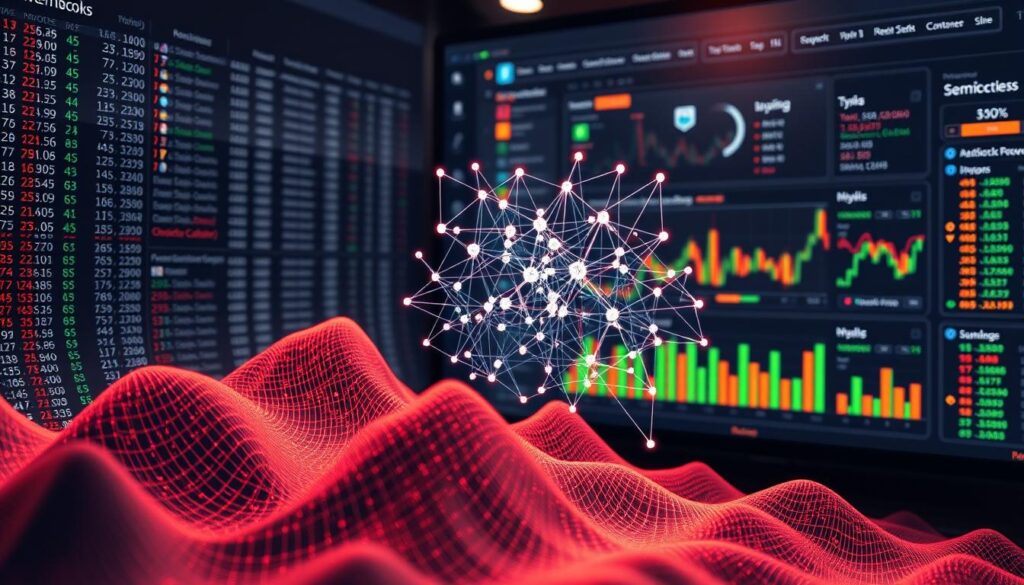Now Reading: Understanding Neural Network Crypto Trading Algorithm
- 01
Understanding Neural Network Crypto Trading Algorithm
Understanding Neural Network Crypto Trading Algorithm

The world of digital assets moves fast. Prices can change in an instant. This creates a unique challenge for investors. To keep up, many turn to advanced technology.
This approach uses artificial intelligence to analyze markets. It can process huge amounts of information quickly. The system looks at price history, market activity, and other data points. It learns from patterns to make informed choices.
Unlike traditional methods, this framework works around the clock. It handles the extreme ups and downs of the market. By using sophisticated AI trading methods, it aims for better performance. The goal is to identify trends and manage risk with high accuracy.
This introduction explores how these powerful models operate. We will see how they turn complex data into clear signals for action.
Key Takeaways
- Advanced AI systems can analyze cryptocurrency markets automatically and continuously.
- These models process multiple data sources, like price history and market activity, simultaneously.
- The primary advantage is speed, executing decisions much faster than any human could.
- This technology is designed to adapt to the high volatility of digital asset markets.
- It aims to identify profitable patterns and trends across different time frames.
- A key benefit is the systematic management of investment risk.
- This represents a significant evolution from basic technical analysis tools.
Introduction to Neural Network Crypto Trading Algorithm
Modern financial analysis has evolved from simple chart patterns to complex mathematical frameworks that process vast datasets. These advanced systems can identify subtle relationships across multiple market dimensions simultaneously.
The core of this approach involves interconnected nodes that process information through multiple layers. This structure enables the identification of profitable opportunities by recognizing patterns in historical price movements and volume data.
Traditional rule-based systems follow fixed instructions. In contrast, adaptive learning frameworks improve their performance over time through continuous training on market information.
| Traditional Systems | Modern Approaches | Key Advantages |
|---|---|---|
| Fixed rule-based logic | Adaptive learning capabilities | Continuous improvement |
| Limited data processing | Multi-dimensional analysis | Better pattern recognition |
| Manual parameter tuning | Automatic feature optimization | Reduced human intervention |
| Linear relationships | Non-linear pattern detection | Superior prediction accuracy |
Successful implementation requires robust data infrastructure and sophisticated risk management. The system must execute decisions within milliseconds of signal generation to capitalize on fleeting market opportunities.
Understanding how these models learn from historical patterns forms the foundation for appreciating more advanced techniques. This knowledge prepares readers for the detailed discussions in subsequent sections.
Foundations of Neural Networks in Financial Trading
The architecture of modern financial systems draws inspiration from biological information processing. These computational frameworks consist of interconnected nodes arranged in multiple layers. Each layer extracts increasingly sophisticated patterns from market information.
Deep learning models differ from traditional approaches through their automatic feature discovery. Instead of manual indicator selection, these systems identify relevant patterns directly from raw data. This capability provides significant advantages for complex financial markets.
The training process involves feeding historical market data through the layered structure. The system compares its predictions against actual outcomes, then adjusts internal parameters to improve accuracy. This continuous refinement enhances prediction performance over time.
Different architectural designs serve distinct purposes in market analysis. Feedforward systems excel at classification tasks, while recurrent models handle time series data effectively. Each architecture brings unique strengths to financial prediction challenges.
Activation functions introduce necessary non-linearity into these computational models. This enables the capture of complex relationships between various market indicators. The result is a more nuanced understanding of price movements and trend patterns.
Cryptocurrency Market Dynamics and Signal Generation
The landscape of virtual asset markets is defined by their non-stop nature and data-rich environment. These platforms operate continuously without traditional closing hours. This creates a constant stream of price information across multiple exchanges.
Extreme price swings characterize these markets. While risky for manual investors, these fluctuations provide abundant patterns for automated systems. Machine learning frameworks can identify exploitable trends in this volatility.
Blockchain technology offers unprecedented transparency through on-chain metrics. Transaction volumes, wallet movements, and network activity serve as leading indicators. This data availability enables sophisticated market analysis beyond traditional financial markets.
Signal generation involves processing multiple data streams simultaneously. Systems analyze traditional market data, orderbook depth, on-chain metrics, and sentiment indicators. The goal is to transform these diverse sources into unified pressure signals.
| Data Source | Key Information | Prediction Value |
|---|---|---|
| Orderbook Depth | Real-time supply/demand imbalances | Short-term price pressure |
| On-Chain Metrics | Network activity and transaction flows | Medium-term trend direction |
| Market Sentiment | Social media and news analysis | Momentum and volatility expectations |
| Price History | OHLCV patterns across timeframes | Technical pattern recognition |
Market microstructure analysis reveals how orderbook imbalances often precede directional movements. When buy orders significantly outweigh sell orders, upward pressure typically follows. Sophisticated models can detect these imbalances early.
Fragmented liquidity across exchanges creates arbitrage opportunities. Price differences between platforms represent temporary inefficiencies. Automated systems can capitalize on these discrepancies before markets equilibrate.
Navigating Data Processing and Feature Engineering
The foundation of any successful predictive system lies in its data preparation pipeline. Raw market information must be carefully cleaned and structured. This process ensures the model receives high-quality input for accurate learning.
Proper preparation prevents numerical imbalances from skewing results. It also helps the system identify meaningful patterns across different data types.
Data Normalization Techniques
Normalization adjusts all input values to a common scale. This step is critical for stable model performance. Features with larger numbers can otherwise dominate the learning process.
Using fixed scaling parameters from initial training is a key advantage. It prevents data snooping and maintains consistency during live analysis. This approach enhances prediction reliability.
| Method | Function | Best For |
|---|---|---|
| Min-Max Scaling | Transforms values to a 0-1 range | Data with known bounds |
| Z-Score Standardization | Centers data around the mean | Handling outlier values |
| Robust Scaling | Uses median and interquartile range | Datasets with many outliers |

Feature Extraction Methods
Feature engineering creates new indicators from raw price and volume data. Technical analysis tools like RSI and moving averages are common examples. These derived values help capture complex market dynamics.
Extracting the same features across multiple timeframes is a powerful technique. It allows the model to analyze patterns that unfold over different periods. This multi-scale analysis improves the overall accuracy of the system.
Data synchronization across all sources is essential. It ensures that information from different streams aligns correctly in time. This prevents look-ahead bias and maintains the integrity of the learning process.
Implementing Technical Analysis and Trend Identification
Technical indicators serve as the fundamental building blocks for market prediction systems. These mathematical tools transform raw price action into structured features. The system processes these values across multiple time horizons.
Utilizing ATR, EMA, RSI, and MACD Indicators
The Average True Range (ATR) measures market volatility effectively. It calculates price movement ranges to help with position sizing. This provides crucial context for current market conditions.
Exponential Moving Averages (EMA) emphasize recent price data. They create dynamic support and resistance levels. Multiple EMA periods reveal trend strength and potential reversal points.
The Relative Strength Index (RSI) quantifies momentum through gain/loss comparisons. Values above 70 suggest overbought conditions. Values below 30 indicate potential oversold situations.
MACD combines moving averages to identify trend changes. Crossovers between its components generate traditional signals. This offers insight into momentum shifts and direction changes.
Customizing Parameters for Volatility and Momentum
Custom time periods enhance indicator effectiveness. The system uses twelve different intervals from 6 to 55. This multi-scale approach captures patterns across various horizons.
Volatility tools like Bollinger Bands define dynamic price boundaries. They expand during active markets and contract during calm periods. This contextualizes price movements within current market conditions.
Momentum indicators including ROC measure price movement speed. They help identify whether trends are accelerating or slowing. Volume-based tools like VWAP reveal conviction behind price moves.
The Elliott Wave Oscillator captures cyclical market psychology. It compares short and long-term averages to identify patterns. This adds another dimension to the overall analysis.
Deep Learning Models and Architecture Insights
Advanced computational frameworks have revolutionized how we analyze financial time series data. These sophisticated systems process market information through specialized layers that extract meaningful patterns.

Convolutional models excel at identifying local patterns across different time horizons. They apply filters to sequential data similar to image recognition. This approach captures subtle relationships in price movements.
Long Short-Term Memory units maintain context over extended periods. They use specialized gates to control information flow. This prevents important signals from fading during processing.
CNN, LSTM, and Transformer Models in Trading
Transformer architectures bring self-attention capabilities to market analysis. They dynamically weight the importance of different time steps. This allows the system to focus on relevant patterns based on current conditions.
The multi-head design assigns specialized processors to different timeframes. Minute-scale heads capture immediate movements. Daily-scale processors identify longer-term structural patterns.
| Model Type | Primary Strength | Best Application |
|---|---|---|
| Convolutional Networks | Local pattern detection | High-frequency analysis |
| LSTM Networks | Long-term dependency | Trend continuation |
| Transformer Models | Dynamic attention weighting | Multi-scale analysis |
Understanding Attention Mechanisms
Attention systems function as learned selection networks. They adaptively combine outputs from different processing heads. During volatile conditions, minute-scale features receive higher weights.
The compact architecture balances capacity with speed requirements. With approximately 520,000 parameters, it maintains excellent performance while enabling real-time decisions. This optimization is crucial for practical implementation.
Designing Multi-Timeframe Trend and Direction Networks
A hierarchical approach to market prediction separates long-term direction from short-term signals. This architecture uses specialized components for different analytical tasks. The system achieves better accuracy by processing information at multiple scales.
Multi-Timeframe Trend Identification
Trend networks analyze longer periods to establish market context. They process Bitcoin dominance metrics and transaction volumes. Multi-timeframe moving averages capture momentum across daily, weekly, and monthly scales.
These components output continuous scores from -1 to +1. This allows nuanced position sizing based on confidence levels. The model maintains stability across different market conditions.
Directional Signal Processing Techniques
Direction networks focus on immediate opportunities within established trends. They process minute-by-minute data for precise entry and exit points. This ensures alignment with prevailing market movements.
The system filters signals through consensus mechanisms. Multiple specialized networks must agree before execution. This approach reduces false signals and improves reliability.
| Component | Timeframe Focus | Primary Inputs | Output Type |
|---|---|---|---|
| Trend Identification | Daily to Monthly | Dominance metrics, Moving averages | Continuous trend score (-1 to +1) |
| Direction Processing | Minute to Hourly | Price action, Orderbook data | Discrete trade signals |
| Signal Validation | Real-time | Multiple network consensus | Filtered execution decisions |
The hierarchical design represents a significant advantage for complex market environments. It combines stability with responsiveness for improved performance.
Integrating Orderbook Data and Sentiment Analysis
Moving beyond basic price charts, the most advanced analytical frameworks tap into the immediate supply-demand balance and collective market mood. This integration provides a deeper, more nuanced view of market forces.

Real-Time Data Integration
Orderbook information reveals the live battle between buyers and sellers. Key metrics like the bid-ask spread, orderbook depth, and the size of the largest orders are constantly analyzed.
Statistical processing over rolling windows—like the last minute or hour—captures microstructural imbalances. These imbalances often signal directional price movements before they happen.
This real-time data processing requires robust infrastructure to handle multiple high-frequency streams with minimal delay. Speed is essential for the signal to remain actionable.
Enhancing Signals with Market Sentiment
Sentiment analysis quantifies the psychological state of the market. It processes text from global news and social media feeds.
The system uses the GDELT dataset, which provides sentiment scores every 15 minutes. This helps the model understand how external events influence market perception.
By learning the relationship between sentiment shifts and price reactions, the framework gains context. It can avoid periods of high uncertainty and improve prediction accuracy.
Combining orderbook dynamics, on-chain analytics, and broad economic indicators creates a robust, multi-source approach. This method helps the system adapt to different market conditions effectively.
Step-by-Step Guide for Model Training and Validation
Building a reliable predictive system requires meticulous preparation and rigorous testing protocols. This process ensures your approach delivers consistent results across different market conditions.
Data Splitting and Backtesting Methods
Proper data organization is crucial for effective learning. Historical information gets divided into three distinct sets for different purposes.
The training set contains 60-70% of data across various market cycles. This allows the system to learn patterns from different environments. Validation sets help tune parameters without overfitting.
Backtesting simulates real-world performance with transaction costs included. Walk-forward analysis provides more robust validation by testing on sequential time periods.
Evaluating Model Performance with Validation Metrics
Multiple metrics assess prediction quality from different angles. Accuracy measures correct directional forecasts. Precision and recall evaluate trade signal effectiveness.
Financial metrics like Sharpe ratio and maximum drawdown provide risk-adjusted performance insights. These values help determine real-world profitability potential.
| Metric Type | Specific Metric | Purpose | Ideal Range |
|---|---|---|---|
| Prediction Quality | Accuracy | Directional correctness | >55% |
| Signal Effectiveness | F1-Score | Precision-recall balance | >0.6 |
| Financial Performance | Sharpe Ratio | Risk-adjusted returns | >1.0 |
| Risk Management | Max Drawdown | Peak-to-trough decline |
Separate evaluation across bull, bear, and sideways markets reveals true robustness. This comprehensive approach ensures reliable performance.
Coding Strategies for Algorithmic Trading Systems
Effective code implementation requires careful consideration of both functionality and computational efficiency. The Python ecosystem offers powerful libraries that streamline development while maintaining high performance.
Well-structured code separates different components into modular units. This approach enhances maintainability and testing capabilities.
Implementing the Solution in Python
Python’s extensive library support simplifies complex financial analysis tasks. Libraries like pandas handle data manipulation efficiently. NumPy provides fast numerical computations for large datasets.
Technical indicator calculation benefits from specialized packages. These tools generate features across multiple timeframes automatically.
Data preprocessing pipelines ensure clean input for model training. Normalization techniques maintain consistent scale across different feature types.
Optimizing Code for Performance and Scalability
Performance optimization focuses on reducing execution time and memory usage. Vectorized operations replace slow Python loops with efficient array computations.
GPU acceleration significantly speeds up training processes for complex models. Proper memory management prevents resource exhaustion during extended runs.
| Optimization Technique | Primary Benefit | Implementation Complexity | Performance Gain |
|---|---|---|---|
| Vectorized Operations | Faster computation | Low | 10-100x |
| GPU Acceleration | Parallel processing | Medium | 5-50x |
| Memory Management | Resource efficiency | Medium | 2-5x |
| Multiprocessing | Concurrent execution | High | 3-8x |
Modular code organization supports easy updates and maintenance. Separate components for data acquisition, processing, and prediction enable targeted improvements.
Leveraging Ensemble Methods in Trading Decisions
Diverse predictive systems working together can significantly enhance the reliability of market forecasts. This collaborative approach combines multiple analytical frameworks to generate more accurate results.
Ensemble learning operates on a simple but powerful principle. Different models make different types of errors that often cancel out when combined. This method reduces overall variance and improves stability.
The system employs both voting and stacking techniques. Voting ensembles use majority rules or weighted averages. Stacking approaches train a meta-model to optimally combine base predictions.
| Ensemble Type | Combination Method | Primary Advantage | Best Use Case |
|---|---|---|---|
| Voting Ensemble | Majority rule or averaging | Simple implementation | Quick consensus building |
| Stacking Ensemble | Meta-model learning | Adaptive weighting | Complex market conditions |
| Weighted Voting | Performance-based influence | Rewards accurate models | Evolving market patterns |
Confidence scoring evaluates both individual model certainty and inter-model agreement. High confidence signals trigger immediate action. Conflicting predictions lead to reduced position sizes or abstention.
Performance improvements from this approach are substantial. Combined models typically achieve 2-5% higher accuracy than individual approaches. They also demonstrate more stable results across different market conditions.
Real-Time Inference and Trade Execution Strategies
The moment of truth for any analytical system arrives when it must act on its insights. This phase transforms predictions into concrete actions within live markets. The system operates through a carefully designed pipeline.

Developing a Real-Time Decision-Making Pipeline
This pipeline continuously processes incoming information streams. It evaluates new data every second or minute based on timeframe requirements. The architecture separates functions into distinct services.
Key components include data collection, preprocessing, model inference, and order execution. These services communicate through message queues for resilience. This design ensures system scalability under heavy load.
The decision process follows a logical sequence. First, trend networks establish the current market regime. Then, appropriate direction models generate specific signals.
- Multiple direction networks evaluate each opportunity
- Ensemble predictions combine individual outputs
- Confidence scores determine action urgency
- High-confidence unanimous decisions trigger immediate execution
Overview of the Execution Process
Execution strategies must account for real-world market impact. Large orders can move prices against the trader’s favor. The system uses advanced order types to minimize this effect.
Limit orders provide price protection but may not fill immediately. Market orders guarantee execution but risk slippage. The framework selects optimal order types based on liquidity conditions.
Risk management operates in parallel with trading logic. It continuously monitors positions and exposure levels. Predefined thresholds automatically trigger protective actions when exceeded.
This comprehensive approach addresses challenges detailed in recent financial technology research. It balances speed with reliability for consistent performance.
Hyperparameter Tuning and Performance Optimization
The process of adjusting foundational settings that govern how a model learns can dramatically impact its real-world effectiveness. These configuration choices are made before training begins and profoundly influence the final results.
Key settings include learning rate, batch size, layer count, and regularization strength. Each parameter affects how the system processes information and improves its prediction accuracy over time.
| Optimization Method | Search Approach | Efficiency Level | Best Use Case |
|---|---|---|---|
| Grid Search | Exhaustive combination testing | Low | Small parameter spaces |
| Random Search | Random sampling of combinations | Medium | Moderate complexity |
| Bayesian Optimization | Intelligent probabilistic selection | High | Large, complex spaces |
Regularization techniques like dropout and L2 penalties prevent overfitting. They force the system to learn robust patterns rather than memorizing specific data points from the training dataset.
Performance optimization extends beyond parameter tuning to include computational efficiency. Techniques like vectorization and batch processing reduce training time while maintaining prediction quality.
The ultimate goal is balancing model complexity with practical constraints. Overly complex approaches may show excellent backtest performance but fail in live environments due to latency or overfitting issues.
Integrating Deep Learning with Traditional Trading Approaches
Combining classical market wisdom with modern computational power creates a powerful synergy for digital asset analysis. This hybrid method uses technical indicators as inputs for sophisticated models rather than relying on fixed rules.
The system learns which combinations work best under different conditions. This addresses limitations of both pure technical analysis and pure machine learning.
Multi-timeframe analysis becomes formalized through separate processing heads. This explicitly models the hierarchical nature of market movements from daily trends to minute-level changes.
Traditional risk management principles can be incorporated into these systems. Position sizing and stop-loss placement based on technical levels enhance the framework’s robustness.
The approach maintains statistical rigor by validating concepts through backtesting. This creates systems that benefit from both domain knowledge and adaptive pattern recognition.
For those implementing an advanced AI trading strategy, this integration offers the best of both worlds. It combines interpretability with performance for more reliable results.
Monitoring Algorithm Performance and Risk Management
The longevity of any automated system hinges on careful observation of performance metrics and safety protocols. This involves tracking key indicators in real-time to ensure consistent results.
Risk Assessment Models and Strategies
Effective risk management begins with proper assessment methods. These approaches quantify potential losses and set protective boundaries.
Value at Risk (VaR) calculations estimate maximum expected losses at specific confidence levels. Position concentration limits prevent over-exposure to single assets.
| Risk Metric | Function | Protective Action |
|---|---|---|
| Maximum Drawdown | Tracks peak-to-trough declines | System pause if exceeded |
| Position Sizing | Adjusts trade sizes dynamically | Reduces exposure during uncertainty |
| Stop-Loss Mechanisms | Automates exit triggers | Prevents catastrophic losses |
Continuous Performance Tracking Techniques
Real-time dashboards provide immediate visibility into system status. They display current positions, recent activity, and data feed health.
Automated alerts notify operators of anomalies like unusual losses or data interruptions. Regular reviews compare live results against backtested expectations.
Performance attribution analysis identifies which components contribute most to profitability. This helps optimize the overall approach for better returns.
Conclusion
Mastering digital asset markets requires integrating diverse methodologies into a cohesive analytical strategy. Our framework demonstrates how combining multi-timeframe trend analysis with high-frequency direction prediction achieves positive risk-adjusted returns.
The system’s ability to process varied data sources—from market metrics to orderbook dynamics—creates unified pressure signals. This approach captures cross-timeframe relationships effectively.
Deep learning models show clear advantages in discovering complex patterns and adapting to changing conditions. The results highlight consistent performance across different market environments.
Success demands expertise in machine learning, financial markets, and statistical analysis. While challenging, the rewards make this a worthwhile pursuit for serious practitioners.
Future developments will likely incorporate additional data sources and improved techniques. Continuous monitoring and adaptation remain essential for maintaining competitive edge.
FAQ
What is the primary advantage of using a deep learning approach for crypto markets?
The main benefit is the system’s ability to learn complex, non-linear patterns from vast amounts of market data. These learning models can identify subtle relationships between various indicators and price movements that traditional technical analysis might miss, potentially leading to more accurate predictions.
How does feature engineering improve the performance of a trading model?
Feature engineering involves creating meaningful input characteristics from raw market data. By extracting relevant features like volatility, momentum, and order book depth, the machine learning framework has higher-quality information to process. This directly enhances the model’s ability to generate reliable signals and improves overall performance.
Which machine learning models are best suited for analyzing time-series price data?
Models like LSTM (Long Short-Term Memory) networks and Transformers are particularly effective. They are designed to handle sequential data, making them ideal for capturing trends and dependencies over time. Their architecture allows them to remember important market information from earlier periods to inform current predictions.
Why is multi-timeframe analysis important for generating trading decisions?
Analyzing multiple timeframes helps the system understand both short-term fluctuations and the broader market trend. This approach provides a more complete picture, reducing the risk of being misled by temporary noise. It allows the algorithm to align its trades with the dominant market direction for better returns.
How is risk management integrated into an automated trading system?
Risk management is built into the process through several methods. This includes setting stop-loss orders based on volatility indicators like ATR, diversifying signals across different timeframes, and continuously monitoring the model’s performance. Validation metrics help assess the strategy’s risk profile before live deployment.
What role does backtesting play in validating a trading algorithm?
Backtesting is a critical step where the model’s logic is applied to historical data to simulate how it would have performed. This process helps evaluate the strategy’s accuracy, potential returns, and robustness under various market conditions without risking actual capital. It’s essential for refining parameters and building confidence.












